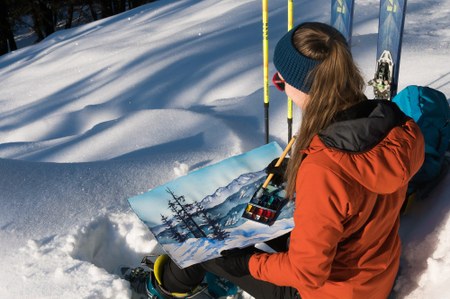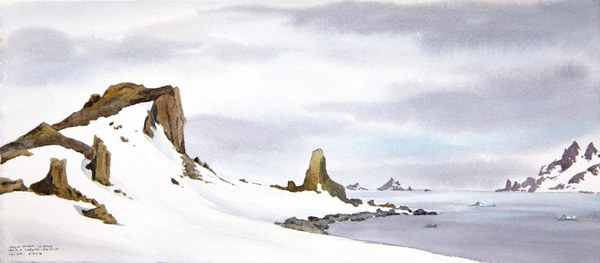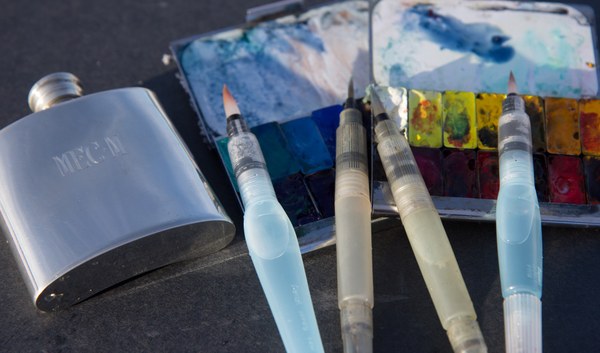
At 5:30am the arctic sun illuminates icebergs with delicate bands of yellow light. My Zodiac ride to explore Disko Bay leaves in 30 minutes, and I need to find vodka, fast.
A cruise ship is like a miniature city, and even small ones feel large when you’re waddling across the decks in too many winter layers. Upon finding an open coffee station, I sheepishly approach the barista. Does she, maybe, have a small bottle of vodka in the back for me? My paints will freeze without it.
Her face lights up in a huge smile, and she stifles a laugh. “Honey, you don’t need an excuse to get vodka at 6am!” she states, as she hands me an expensive (and entirely too full) bottle from under the counter. “We call it Vitamin V, available all the time.” Despite my insistence that I am, in fact, going to fill my brush with vodka to make a painting, the crew does not believe me.

A painting of Half Moon Island in Antarctica. Photo courtesy of Maria Coryell-Martin.
Or, at least, they don’t believe me until I return a few hours later with three small watercolor sketches smelling faintly of liquor. Within a few hours word has spread throughout the ship, and I become known as the “artist who paints with vodka” for the rest of the trip.
Painting with vodka is a tip I learned years earlier from expeditionary artist Maria Coryell-Martin, and it inspired my early morning paintings in the arctic. Maria traveled the world documenting places through art, and she specializes in painting outside in cold climates, like Antarctica. For Maria, winter is actually one of the best times to get outside and paint. “The days are short, the weather is cold and often wet, and it’s tempting to sit inside with a cup of tea instead of braving the elements with a sketchbook. But in spite of the challenges, I think there’s so much value and fun in sketching winter plein air, and it can lead to wonderful inspiration inside your cozy studio later.”

Maria’s flask, palettes, and water brushes. Photo courtesy of Maria Coryell-Martin.
Winter presents a unique set of conditions, but with the right gear, attitude, and preparation, it can be just as fun as painting in fair weather. If you’re thinking about getting outside this winter with a pen or paintbrush in hand, Maria and I have a few go-to tips and tricks to share with you to make the experience fun.
Prepare for the weather with the right equipment
Heading out in wintry weather can take a little extra preparation. As sketching is a stationary sport, we recommend bringing layers. If it’s close to freezing outside, wear a base layer, fleece, insulated down jacket, and a waterproof shell. If you’re hiking to your painting spot, bring a dry t-shirt and sports bra to change into because nothing will chill you faster than sitting still in damp layers. If needed, bundle up with extra scarves, jackets, and lightweight gloves. You will not regret bringing more layers than you think you’ll need! We also recommend sitting on a small foam pad instead of on your pack. Bonus: this keeps snacks more easily accessible without having to get up.
Find painting materials you love
Maria and I both love the Art Toolkit Pocket Pallette, which she invented! We fill the light, compact, and portable palettes with our favorite watercolors from Daniel Smith. We carry either a Moleskine notebook or a variety of loose paper, plus our usual selection of pencils, pens, brushes, and a reusable paper towel. One of our favorite tools is a waterbrush, which has a hollow handle you can fill with water. We also bring a flask filled with vodka or gin if temperatures dip below freezing. The alcohol helps keep the paintbrushes from turning into popsicles, and the paintings might dry a little faster, too.
Find your outdoor inspiration
When time is limited or conditions are particularly challenging, we often start by making quick, small, gesture sketches (a technique Maria taught me over a decade ago on Mount Baker). Creating simple sketches with pen or pencil and a limited palette of colors saves time and helps you focus on the bigger picture of the landscape you’re visiting. When making gestures, “It’s helpful to think of your pen or pencil as a conductor’s baton dancing lightly on your page,” says Maria.
Have fun!
Painting outside any time of the year presents a unique set of challenges. Approaching variable conditions, bad weather, and unpredictable mishaps with a lens of experimentation and fun can make all the difference. In our experience, winter paintings rarely turn out as you want them to, but they will always carry many memories and opportunities to connect with the places you visit.
Bonus: Our favorite places to paint in the winter
Gold Creek pond is a great location to try painting in the winter for the first time. It’s easily accessible, and if you get too cold the car isn’t far away! If you live near Seattle, try painting in the woods on Tiger, Cougar, or Squak Mountains. We also love to visit the Methow Valley in the winter and find its beautiful landscape full of inspiration.
Not all winter painting has to be in the snow. Regardless of where you live, you can always head to a local park or nature preserve. We can learn so much about our surroundings by sitting quietly for ten minutes to sketch.
Claire Giordano is an environmental artist and writer following the interwoven patterns of people, place, and climate change. See more of her work at www.claireswanderings.com. Maria Coryell-Martin is an expeditionary artist in the tradition of traveling artists as naturalists and educators, and the founder of Art Toolkit, offering expedition-proven tools for sketching and painting, from urban to wilderness adventures. Learn more at expeditionaryart.com and art-toolkit.com.
This article originally appeared in our Winter 2021 issue of Mountaineer Magazine. To view the original article in magazine form and read more stories from our publication, visit our magazine archive.
 Claire Giordano
Claire Giordano